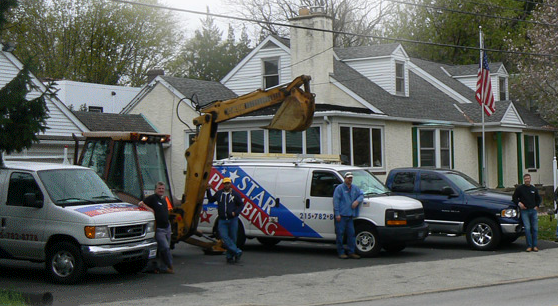When Should You Avoid Using PVC Cement?
PVC cement is a chemical adhesive specifically designed for bonding PVC pipes and fittings. This adhesive is versatile and easy to use, but it’s not suitable for every application. When not to use PVC cement, and what other methods should you use instead?
1. Do not use PVC cement on wet or damp surfaces. Since the adhesive needs to evaporate in order for it to cure properly, the moisture in wet surfaces prevents this from happening and can create weak joints. Instead, you should use a mechanical fitting such as a compression coupling or mechanical coupling to join the two pipes together.
2. Do not use PVC cement on plasticized PVC pipes or fittings. This type of PVC contains additives that prevent the cement from properly bonding with the surface of the pipe or fitting, potentially resulting in leaks down the road. Instead, you should opt for a solvent weld joint which uses an epoxy compound that melts both surfaces into one unified piece when heated up and cooled down quickly.
3. Do not use PVC cement on non-PVC materials like metal, rubber, etc.. The adhesive will not form a proper bond with these materials and could result in leaks or worse if used improperly. Instead, you should opt for a threaded connection or mechanical fitting specifically designed for that material which will provide a much more reliable seal than if you were to try to use PVC cement on them.
Benefits of PVC Cement in Plumbing
PVC cement is a great tool for plumbing projects. It is an adhesive that has been specifically designed to join two pieces of PVC pipe together quickly and easily. The adhesive bonds the two pieces of pipe together, creating a watertight seal that will not leak or break over time. This makes it an ideal solution for many plumbing projects, especially those where the pipes need to fit tightly together without any gaps or leaks.
Advantages of PVC Cement
The use of PVC cement has several advantages compared to traditional methods of joining pipes. It is easy to use and fast drying, so it can be applied quickly and effectively, allowing projects to be completed in a short amount of time. It also creates a strong bond that will not degrade over time, and it is resistant to temperature changes and corrosion, making it a long-lasting solution for your plumbing needs.
Uses of PVC Cement in Plumbing Applications
PVC cement can be used for many different types of plumbing applications, including joining large diameter pipes together, connecting smaller pipes with fittings such as elbows and tees, and sealing connections between two different types of materials such as copper and plastic. It can also be used to seal around threaded fittings such as taps or valves.
When Not To Use PVC Cement?
Although PVC cement can be a very useful tool in certain situations, there are some instances where it should not be used. For example, if the pipes being joined are made from different materials such as copper or steel then the adhesive may not create an effective bond and could lead to leaks or other problems down the line. Additionally, if the pipes are very large in diameter then mechanical joints may be more appropriate due to their strength and durability when properly installed.
Common Mistakes Involving PVC Cement
One common mistake when using PVC cement is applying too much adhesive at once which can lead to excessive seepage around the joint or even warping or buckling of the pipe due to uneven pressure applied by excess adhesive. Additionally, if the joint is not held firmly together while the adhesive cures then it may lead to weak spots which could cause future problems with leaking or other issues with the joint’s integrity over time. Therefore it is important to make sure all joints are properly aligned before applying any adhesive, as any misalignment can lead to major issues down the road.
Potential Damage Caused by Using PVC Cement Improperly
Using too much adhesive in one area can cause warping or buckling of pipe due to uneven pressure from excess material build-up; this can cause leaks at later stages due improper fitment between two sections of piping material which should have been airtightly sealed during installation with just enough material for proper adhesion between surfaces instead too much adhesion causing buckling/warping effect on surface sealing points when trying tightly fit around valves/fittings etc.. Additionally, if left exposed without proper protection (such as a heat sink) during curing process then heat generated from solidification process could weaken overall joint strength leading into potential failure due lack structural integrity at later stage post installation period over time if left unprotected from direct sunlight exposure on hot summer days etc..
Types of Pipe Joining Methods Not Requiring PVC Cement
There are several alternative methods available for joining pipes without using PVC cement; these include mechanical joints such as compression fittings or flanged connections which utilize bolts and nuts along with special gaskets for creating watertight seals; these provide higher levels of protection against leakage compared traditional glue-based techniques when correctly assembled by certified plumbers/technicians etc.. Additionally there are also heat fusion techniques available where sections are heated up prior joining process so that molten plastic material forms strong bond between them upon cooling stage providing additional strength against potential leakages occurring over time after years usage etc..
Other Alternatives To Using PVC Cement For Plumbing
In addition to mechanical joints and heat fusion methods there are also sealants available which can be used for joining pipes together; these provide extra protection against water leakage due its flexibility allowing it form tight seals around curved edges along with its resistance towards temperature changes making them ideal solutions when dealing larger piping systems where welding/soldering processes must be avoided during installation period etc.. Primers can also sometimes be used prior applying glue onto surfaces aimed reducing friction while creating airtight seals between two sections being joined together reducing chances leakages occurring after curing process taking place etc..
How To Correctly Seal A Pipe Without Using PVC Cement
Proper Handling and Storage of PVC Cement
It’s important to handle and store PVC cement correctly in order to get the best results. Moisture in the canister can cause the cement to become ineffective, so it’s important to keep it away from moisture. Additionally, preheating before use can help ensure that the cement adheres properly.
Hazards of Incorrect Use of PVC Cement
When not used correctly, PVC cement can be hazardous. Toxic fumes can be created when using an incorrect type or amount of cement, so proper precautions should be taken when using it. Additionally, improper use may create a fire or explosion risk due to the flammable nature of the cement.
Materials Not Suitable For Use With PVC Cement
There are certain materials that should not be used with PVC cement as they may not adhere properly or create hazardous fumes. Dip coatings and asbestos containing materials should never be used with this type of adhesive.
Tips for Professionals Using PVC Cements
Professionals working with PVC cements should take certain steps to ensure safety and proper adherence. Choosing a good grade adhesive is important for optimal results, and wearing protective gear is necessary for safety purposes. Additionally, it’s important to read all instructions carefully before use in order to avoid any potential hazards or mistakes.
FAQ & Answers
Q: What are the benefits of using PVC Cement in plumbing?
A: PVC Cement provides a strong, durable bond between two pieces of PVC pipe. It is a fast and easy way to join pieces of pipe without the need for additional hardware, like clamps or bolts. PVC cement also creates an airtight seal, which prevents water and other liquids from leaking.
Q: When should I avoid using PVC Cement?
A: You should avoid using PVC cement if you are not experienced with plumbing or if the job requires joining pipes of different sizes or materials. If you have any doubts about your ability to make the connection correctly, it is best to seek professional help. Additionally, you should avoid using PVC cement in applications where it could come into contact with certain substances such as dip coatings or asbestos-containing materials.
Q: What types of pipe joining methods do not require PVC Cement?
A: Mechanical joints and heat fusion methods can be used as alternatives to using PVC cement. Mechanical joints involve connecting two pieces of pipe without the use of an adhesive, while heat fusion involves heating two pieces of plastic pipe together and then cooling them down to form a solid bond.
Q: How can I correctly seal a pipe without using PVC Cement?
A: Before attempting to seal a pipe without the use of PVC cement, it is important to test the connection points for leaks by running water through them. If there are no leaks, you can then use compression fittings or other sealing materials such as sealants or primers for glued joints.
Q: What hazards may result from incorrect use of PVC Cement?
A: Incorrect use of PVC cement can lead to toxic fumes being released into the air and potential fire and explosion risks due to reactions between certain chemicals in the cement and other substances. It is also important to note that incorrect storage or handling could cause moisture in the canister which could lead to reduced effectiveness when applied.
In conclusion, PVC cement should not be used in situations where it could potentially be exposed to harsh conditions or chemical exposure. Additionally, it should not be used as a substitute for proper tightening of pipe fittings and couplings, as this could lead to leaks and other plumbing problems. PVC cement is best reserved for indoor use, where it will not be exposed to extreme temperatures or chemicals. PVC cement is a great tool when used correctly, but caution should always be taken when using any type of adhesive in a plumbing system.
Author Profile

-
Star Plumbing, located in Elkins Park, PA, is a full-service plumbing company owned and operated by Mitchell Gordon. Since its inception, Star Plumbing has been providing its customers with reliable, quality plumbing services.
The Star Plumbing website offers informative articles on DIY plumbing and plumbing equipment, offering readers helpful advice and tips on how to take care of their own plumbing needs. This is a great resource for those who are looking to tackle a plumbing project themselves, as it provides useful information and advice on how to safely and successfully complete a plumbing job. Additionally, the website provides detailed descriptions of the various plumbing tools and equipment that are available, as well as detailed instructions on how to use them.
Star Plumbing’s website is a great resource for anyone with plumbing needs. Whether a customer is looking for advice on how to take care of their own plumbing or to schedule service from Star Plumbing, the website offers helpful advice and information for all their plumbing needs.
Latest entries
- April 12, 2024Plumbing Equipment And AccesoriesI Tested And Ranked The Best 10 Inch Rough In Round Toilet In 2024: And Here’s What I Found
- April 12, 2024Plumbing Equipment And AccesoriesI Tested And Ranked The Best Stone That Cleans Toilets In 2024: And Here’s What I Found
- April 12, 2024Plumbing Equipment And AccesoriesI Tested And Ranked The Best Heat Tape For Plumbing In 2024: And Here’s What I Found
- April 12, 2024Plumbing Equipment And AccesoriesI Tested And Ranked The Best Kaboom Toilet Bowl Tablets In 2024: And Here’s What I Found
